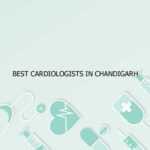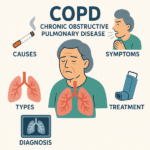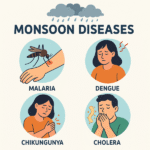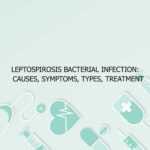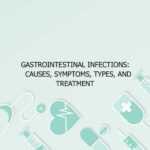Now Reading: COPD (Chronic Obstructive Pulmonary Disease): Causes, Symptoms, Types, Diagnosis, and Treatment
-
01
COPD (Chronic Obstructive Pulmonary Disease): Causes, Symptoms, Types, Diagnosis, and Treatment
COPD (Chronic Obstructive Pulmonary Disease): Causes, Symptoms, Types, Diagnosis, and Treatment
COPD (Chronic Obstructive Pulmonary Disease) is a progressive and debilitating lung condition characterized by persistent airflow limitation. It is an umbrella term that includes two main conditions—chronic bronchitis and emphysema—both of which contribute to breathing difficulties and impaired lung function. COPD (Chronic Obstructive Pulmonary Disease) is among the leading causes of morbidity and mortality globally, affecting millions of people and contributing to significant healthcare burdens.
This disease primarily affects adults and older individuals, particularly those with a history of smoking, long-term exposure to air pollutants, or genetic susceptibility. It is a preventable and treatable condition, but early diagnosis and timely intervention are crucial to slow its progression. In this detailed article, we will explore the causes, symptoms, types, diagnostic procedures, and available treatments for COPD (Chronic Obstructive Pulmonary Disease).
Causes of COPD (Chronic Obstructive Pulmonary Disease)
The leading cause of COPD (Chronic Obstructive Pulmonary Disease) is long-term exposure to substances that irritate and damage the lungs. The most common factor is cigarette smoking, accounting for up to 90% of cases in developed countries. However, other risk factors can also lead to or exacerbate the condition.
- Cigarette Smoking: This is the most significant risk factor for developing COPD (Chronic Obstructive Pulmonary Disease). The inhalation of smoke over time causes inflammation and destruction of lung tissue and narrows the airways, leading to obstructed airflow.
- Air Pollution: Long-term exposure to indoor air pollutants such as biomass fuels (used for cooking and heating) or outdoor pollutants like vehicle emissions can contribute to lung damage.
- Occupational Exposure: Individuals working in environments with dust, chemical fumes, and industrial pollutants are at a higher risk of developing COPD (Chronic Obstructive Pulmonary Disease).
- Genetics: A rare genetic disorder called alpha-1 antitrypsin deficiency can cause early-onset COPD (Chronic Obstructive Pulmonary Disease), even in non-smokers.
- Respiratory Infections: Severe and recurrent respiratory infections during childhood can impair lung development and function, increasing the risk later in life.
Understanding these causative factors is essential in developing public health strategies to reduce the prevalence and burden of COPD (Chronic Obstructive Pulmonary Disease).
Symptoms of COPD (Chronic Obstructive Pulmonary Disease)
Symptoms of COPD (Chronic Obstructive Pulmonary Disease) typically develop gradually and worsen over time. The onset is often insidious, and many patients may not seek medical attention until the disease is advanced. Key symptoms include:
- Chronic Cough: Often the first sign, this is typically a productive cough with mucus that lasts for several months each year.
- Shortness of Breath (Dyspnea): Initially occurs during exertion, but over time, even simple activities like walking or dressing may cause breathlessness.
- Wheezing: A high-pitched whistling sound during breathing due to narrowed airways.
- Chest Tightness: Patients often feel a sensation of tightness or heaviness in the chest.
- Frequent Respiratory Infections: Individuals with COPD (Chronic Obstructive Pulmonary Disease) are more prone to recurrent episodes of bronchitis and pneumonia.
- Fatigue and Reduced Exercise Tolerance: As the disease progresses, patients find it increasingly difficult to engage in physical activities.
- Weight Loss and Muscle Wasting: In advanced stages, the energy required for breathing increases, resulting in unintended weight loss and reduced muscle mass.
Recognizing these symptoms early and correlating them with risk factors can prompt timely diagnostic evaluations.
Types of COPD (Chronic Obstructive Pulmonary Disease)
There are two main subtypes of COPD (Chronic Obstructive Pulmonary Disease), which often coexist but may present with predominance of one over the other:
Chronic Bronchitis
This condition is characterized by chronic inflammation of the bronchial tubes, leading to increased mucus production and airway obstruction. The hallmark of chronic bronchitis is a productive cough that lasts for at least three months in two consecutive years. In chronic bronchitis, the airways are inflamed and narrowed, making it hard to move air in and out of the lungs.
Emphysema
Emphysema involves the destruction of the alveoli (tiny air sacs in the lungs) where gas exchange occurs. This results in reduced surface area for oxygen absorption and leads to air trapping in the lungs. Patients with emphysema often exhibit a “barrel chest” appearance and experience severe breathlessness even at rest.
Some individuals may also have asthma-COPD overlap syndrome (ACOS), where symptoms of both asthma and COPD (Chronic Obstructive Pulmonary Disease) are present. Recognizing the type and overlap helps tailor treatment strategies.
Diagnosis of COPD (Chronic Obstructive Pulmonary Disease)
Early and accurate diagnosis of COPD (Chronic Obstructive Pulmonary Disease) is crucial for effective management. The diagnostic process includes clinical evaluation, spirometry, imaging, and laboratory tests.
- Clinical History and Physical Examination: A detailed history including smoking status, occupational exposure, and symptom duration is essential. During examination, wheezing, prolonged expiration, and use of accessory muscles may be noted.
- Spirometry: This is the gold standard diagnostic test for COPD (Chronic Obstructive Pulmonary Disease). It measures the volume and speed of air a person can exhale. A post-bronchodilator FEV1/FVC ratio of less than 0.70 confirms the diagnosis.
- Chest X-ray or CT Scan: Imaging may show signs of lung hyperinflation, flattened diaphragm, or areas of emphysema. CT scans provide more detailed visualization and help differentiate from other lung diseases.
- Arterial Blood Gases (ABG): ABG analysis may be performed to assess oxygen and carbon dioxide levels in advanced disease.
- Alpha-1 Antitrypsin Testing: This genetic test is recommended for patients with early-onset COPD (Chronic Obstructive Pulmonary Disease) or a family history of lung disease.
Diagnostic accuracy helps classify the severity of COPD (Chronic Obstructive Pulmonary Disease), which is vital for treatment planning.
Treatment of COPD (Chronic Obstructive Pulmonary Disease)
Though COPD (Chronic Obstructive Pulmonary Disease) is not curable, it can be managed effectively to improve quality of life and slow progression. Treatment involves a combination of pharmacological and non-pharmacological strategies.
Pharmacological Treatment
- Bronchodilators: These medications relax airway muscles and are the mainstay of symptom relief. They can be short-acting (e.g., salbutamol) or long-acting (e.g., tiotropium).
- Inhaled Corticosteroids: Used in combination with bronchodilators, especially in patients with frequent exacerbations.
- Phosphodiesterase-4 Inhibitors: These reduce inflammation and may be useful in severe chronic bronchitis.
- Antibiotics and Antivirals: Prescribed during acute exacerbations to manage infections.
- Mucolytics: Help thin mucus and facilitate its expulsion.
Non-Pharmacological Management
- Smoking Cessation: This is the most important intervention in managing and slowing the progression of COPD (Chronic Obstructive Pulmonary Disease).
- Pulmonary Rehabilitation: A multidisciplinary program that includes exercise training, nutrition counseling, and education.
- Oxygen Therapy: Recommended for patients with chronic hypoxemia to improve survival and reduce complications.
- Surgical Interventions: In select cases, procedures such as lung volume reduction surgery or lung transplantation may be considered.
- Vaccinations: Influenza and pneumococcal vaccines are essential to prevent respiratory infections.
Treatment is tailored based on severity, symptoms, comorbidities, and patient preferences.
Table: COPD (Chronic Obstructive Pulmonary Disease) Symptoms and Associated Features
| Symptom/Feature | Description |
|---|---|
| Chronic Cough | Persistent cough with mucus lasting over 3 months a year |
| Shortness of Breath | Difficulty breathing during activity or at rest |
| Wheezing | High-pitched breathing sound due to narrowed airways |
| Chest Tightness | Sensation of pressure or discomfort in the chest |
| Frequent Infections | Recurrent bouts of bronchitis or pneumonia |
| Fatigue | Persistent tiredness and lack of energy |
| Weight Loss | Unintentional loss of body mass and muscle |
| Barrel Chest | Rounded chest appearance due to air trapping |
| Clubbing of Fingers | Swelling of fingertips in advanced stages |
| Cyanosis | Bluish discoloration of lips and fingernails (severe cases) |
10 Frequently Asked Questions about COPD (Chronic Obstructive Pulmonary Disease)
What is COPD (Chronic Obstructive Pulmonary Disease) and how does it affect the lungs?
COPD (Chronic Obstructive Pulmonary Disease) is a chronic inflammatory lung condition that obstructs airflow from the lungs. It encompasses chronic bronchitis, which causes inflammation and excessive mucus production, and emphysema, which leads to alveolar destruction and reduced oxygen exchange. The condition makes it progressively harder to breathe and perform daily activities. COPD (Chronic Obstructive Pulmonary Disease) develops over years and is primarily caused by exposure to harmful particles or gases, most commonly from smoking. Over time, lung elasticity decreases, airways become swollen, and gas exchange becomes inefficient, resulting in shortness of breath, cough, and reduced exercise capacity.
How is COPD (Chronic Obstructive Pulmonary Disease) different from asthma?
Although both COPD (Chronic Obstructive Pulmonary Disease) and asthma involve airway obstruction, they differ significantly in causes, progression, and reversibility. Asthma usually begins in childhood, often triggered by allergens, and its symptoms are reversible with medication. COPD (Chronic Obstructive Pulmonary Disease), however, typically affects adults and progresses over time with partial or irreversible airflow limitation. While asthma responds well to corticosteroids, COPD (Chronic Obstructive Pulmonary Disease) requires long-term bronchodilator therapy and lifestyle changes. In some cases, people may suffer from both conditions, a situation referred to as asthma-COPD overlap syndrome (ACOS), which requires a unique treatment approach.
What causes COPD (Chronic Obstructive Pulmonary Disease) in non-smokers?
While smoking is the most common cause of COPD (Chronic Obstructive Pulmonary Disease), non-smokers can also develop the condition due to other risk factors. Prolonged exposure to indoor pollutants such as wood smoke from cooking, environmental pollution, genetic predispositions like alpha-1 antitrypsin deficiency, and a history of recurrent childhood respiratory infections can all contribute. Occupational exposure to dust, fumes, and chemicals also plays a significant role. Identifying these factors is critical for early diagnosis and prevention strategies, especially in developing regions where indoor air pollution is a common issue.
Is COPD (Chronic Obstructive Pulmonary Disease) reversible or curable?
COPD (Chronic Obstructive Pulmonary Disease) is not reversible or curable, but it is treatable. The progression of the disease can be slowed with appropriate interventions such as quitting smoking, using prescribed inhalers, enrolling in pulmonary rehabilitation, and maintaining regular follow-ups. Early diagnosis significantly improves prognosis. Although the structural changes in the lungs cannot be undone, symptom control and quality of life can be significantly enhanced. Long-term oxygen therapy and surgical options may also benefit patients in advanced stages, highlighting the importance of a tailored, multidisciplinary approach to care.
What is the role of pulmonary rehabilitation in COPD (Chronic Obstructive Pulmonary Disease)?
Pulmonary rehabilitation is a cornerstone of COPD (Chronic Obstructive Pulmonary Disease) management. It is a structured program combining exercise training, education, nutritional advice, and psychological support aimed at improving the overall well-being of patients. These programs enhance lung function, reduce symptoms like breathlessness, and increase physical endurance. They also provide strategies to manage flare-ups and anxiety associated with breathlessness. Pulmonary rehabilitation significantly improves the quality of life and reduces hospitalizations in patients with moderate to severe COPD (Chronic Obstructive Pulmonary Disease), making it an essential component of comprehensive care.
How is COPD (Chronic Obstructive Pulmonary Disease) diagnosed and what tests are used?
COPD (Chronic Obstructive Pulmonary Disease) is primarily diagnosed through spirometry, a test that measures how much air a person can inhale and exhale and how quickly. A low FEV1/FVC ratio post-bronchodilator indicates airflow obstruction. Additional diagnostic tools include chest X-rays or CT scans to assess lung damage and rule out other conditions. Blood tests may evaluate oxygen and carbon dioxide levels or detect alpha-1 antitrypsin deficiency. A thorough medical history and physical examination are also essential. Diagnosis not only confirms the disease but helps determine its severity and guide treatment plans.
Can lifestyle changes improve COPD (Chronic Obstructive Pulmonary Disease)?
Absolutely, lifestyle changes can significantly improve the management and outcomes of COPD (Chronic Obstructive Pulmonary Disease). The most critical step is quitting smoking, which halts further lung damage. Regular physical activity helps maintain muscle strength and cardiovascular fitness. A balanced diet supports overall health, while weight management can improve breathing efficiency. Staying up-to-date with vaccinations reduces the risk of respiratory infections. Avoiding exposure to pollutants, maintaining indoor air quality, and managing comorbidities like diabetes or heart disease all contribute to improved quality of life in COPD (Chronic Obstructive Pulmonary Disease) patients.
What are exacerbations in COPD (Chronic Obstructive Pulmonary Disease) and how can they be prevented?
Exacerbations are sudden worsening of symptoms such as increased breathlessness, cough, and sputum production. They can be triggered by infections, environmental pollutants, or even changes in weather. Frequent exacerbations accelerate disease progression, reduce lung function, and increase hospitalization risks. Prevention strategies include consistent use of maintenance medications, vaccinations, early treatment of infections, and adherence to a personalized action plan. Pulmonary rehabilitation and self-management education also empower patients to recognize and respond to early signs of exacerbation, thus minimizing complications in COPD (Chronic Obstructive Pulmonary Disease).
How does COPD (Chronic Obstructive Pulmonary Disease) affect daily life and mental health?
COPD (Chronic Obstructive Pulmonary Disease) can significantly affect day-to-day functioning due to persistent breathlessness and fatigue. Patients often struggle with routine tasks, leading to frustration, anxiety, and social withdrawal. Depression is common, especially in advanced stages. The emotional burden may also stem from frequent hospital visits and fears about disease progression. Support from caregivers, mental health professionals, and COPD-specific support groups can make a considerable difference. Integrating psychological care into the treatment plan of COPD (Chronic Obstructive Pulmonary Disease) patients is vital for holistic well-being.
Is there any hope for a cure or better treatment for COPD (Chronic Obstructive Pulmonary Disease) in the future?
Although a complete cure for COPD (Chronic Obstructive Pulmonary Disease) is not currently available, ongoing research is promising. Advances in gene therapy, regenerative medicine, and new pharmacological agents offer hope. Clinical trials are exploring anti-inflammatory drugs, biological therapies, and stem cell treatments. Efforts to understand disease mechanisms at the molecular level are paving the way for personalized medicine. Innovations in digital health, such as remote monitoring and AI-driven symptom tracking, also hold potential for enhancing disease management. The future holds optimism for better outcomes in COPD (Chronic Obstructive Pulmonary Disease).
Medical Journals on COPD (Chronic Obstructive Pulmonary Disease)
| Journal Title & Description | Author(s) |
|---|---|
| “Global Burden of COPD: Epidemiology and Risk Factors” – A comprehensive overview of global prevalence | Dr. Michael Soriano, Dr. Lisa Tan |
| “Smoking and COPD: The Deadly Link” – Examining the role of tobacco in disease development | Dr. Rajeev Kumar, Dr. Anna Shaw |
| “Advances in Inhaled Therapy for COPD” – A review of bronchodilator innovations | Dr. Kevin L. Wu |
| “Pulmonary Rehabilitation and COPD Outcomes” – Evaluating the effectiveness of rehab programs | Dr. Sandra Lopez, Dr. Neil Thompson |
| “Exacerbation Management in Chronic Obstructive Pulmonary Disease” – Clinical guidelines and treatment protocols | Dr. Farah Ali |
| “Air Pollution and Its Role in Non-Smoking COPD” – Focused on environmental triggers | Dr. Mohan Desai, Dr. Yue Chen |
| “The Genetics of COPD: A New Frontier” – Exploring alpha-1 antitrypsin deficiency and beyond | Dr. Lorna Patel |
| “Digital Monitoring Tools in COPD Management” – Role of apps and AI in patient care | Dr. Tobias Reich |
| “COPD and Mental Health: A Dual Burden” – Discusses the psychological aspects of chronic lung disease | Dr. Emily Winters |
| “Emerging Therapies in Chronic Obstructive Pulmonary Disease” – Investigating novel treatments and future directions | Dr. Christine Morgan |
